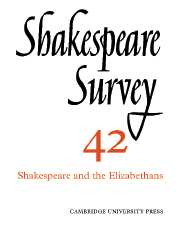Book contents
- Frontmatter
- ‘Jack hath not Jill’: Failed Courtship in Lyly and Shakespeare
- Truth and Art in History Plays
- Chronicles and Mythmaking in Shakespeare’s Joan of Arc
- King John and Embarrassing Women
- Golding’s Ovid, Shakespeare’s ‘Small Latin’, and the Real Object of Mockery in ‘Pyramus and Thisbe’
- Ovid and the Sonnets; or, did Shakespeare Feel the Anxiety of Influence?
- The Play of Sir Thomas More and Some Contemporary Events
- ‘Nobody’s Perfect’: Actors’ Memories and Shakespeare’s Plays of the 1590s
- The Boyhood of Shakespeare’s Heroines
- Shakespeare’s ‘Brawl Ridiculous’
- Shakespeare’s Handwriting
- Shakespeare Performances in England, 1987–8
- Professional Shakespeare Productions in the British Isles, January-December 1987
- The Year's Contributions to Shakespearian Study 1 Critical Studies
- 2 Shakespeare’s Life, Times, and Stage
- 3 Editions and Textual Studies
- Books Received
- Index
King John and Embarrassing Women
Published online by Cambridge University Press: 28 March 2007
- Frontmatter
- ‘Jack hath not Jill’: Failed Courtship in Lyly and Shakespeare
- Truth and Art in History Plays
- Chronicles and Mythmaking in Shakespeare’s Joan of Arc
- King John and Embarrassing Women
- Golding’s Ovid, Shakespeare’s ‘Small Latin’, and the Real Object of Mockery in ‘Pyramus and Thisbe’
- Ovid and the Sonnets; or, did Shakespeare Feel the Anxiety of Influence?
- The Play of Sir Thomas More and Some Contemporary Events
- ‘Nobody’s Perfect’: Actors’ Memories and Shakespeare’s Plays of the 1590s
- The Boyhood of Shakespeare’s Heroines
- Shakespeare’s ‘Brawl Ridiculous’
- Shakespeare’s Handwriting
- Shakespeare Performances in England, 1987–8
- Professional Shakespeare Productions in the British Isles, January-December 1987
- The Year's Contributions to Shakespearian Study 1 Critical Studies
- 2 Shakespeare’s Life, Times, and Stage
- 3 Editions and Textual Studies
- Books Received
- Index
Summary
Compared with almost any other play of Shakespeare’s, King John has had a poor press both in quantity of what is written about it and also in the faint praise accorded to it. This lack of interest has been reflected in its stage history. Arthur Colby Sprague wrote in 1945 that the play is ‘now almost unknown as an acting play’. When it was put on in the Old Vic season of 1953–4 the editors of a commemorative volume (Roger Wood and Mary Clarke) record that ‘it only just maintained a 75 per cent attendance record’, and that ‘this was in spite of good reviews and first-rate acting’ (by a cast which included Fay Compton as Constance, Richard Burton as Falconbridge, and Michael Hordern as John). They conclude that this lukewarm reception ‘must be attributed to the play’s own comparative unpopularity’. Wood and Clarke consider King John to be ‘purely medieval’, and add that ‘a play of such mixed fabric, where every man is for himself and no common purpose or theme emerges, presents many problems to the producer’. In 1988 one might feel less confident in declaring that a drama in which every man is out for himself represents the medieval rather than the modern world. Perhaps Garrick’s idea for a production which was ‘half old English and half modern’ both identifies and solves the problem. In the later twentieth century King John has not – at least until the advent of Deborah Warner’s excellent 1988 production at The Other Place in Stratford-upon-Avon – shared notably in the revival of enthusiasm about Shakespeare’s other history plays set in motion by John Barton’s adaptations and productions.
- Type
- Chapter
- Information
- Shakespeare Survey , pp. 37 - 52Publisher: Cambridge University PressPrint publication year: 1990
- 4
- Cited by

